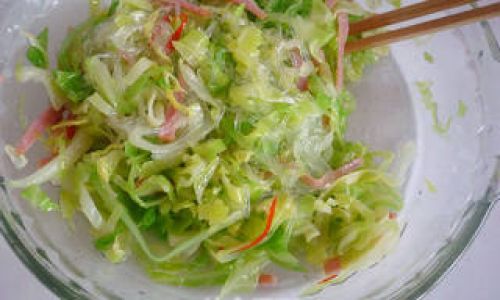Introduction
In the vast culinary landscape of China, where flavors range from the subtly sweet to the fiery hot, one dish stands out for its simplicity and refreshing taste: Qiangban Cabbage, or Spicy and Vinegared Cabbage Salad. This dish, though seemingly humble, encapsulates the essence of Chinese home cooking—a harmonious blend of bold flavors, fresh ingredients, and minimalism. Qiangban Cabbage is not merely a salad; it’s a testament to the art of balancing contrasting tastes and textures in a single bowl.
Originating from the northern regions of China, where cabbage is abundant and winters are harsh, Qiangban Cabbage has evolved into a beloved staple across the country. Its appeal lies in its ability to elevate a humble vegetable into a vibrant, mouthwatering dish through the clever use of spices, vinegar, and oil. In this article, we will delve into the intricacies of making Qiangban Cabbage, from selecting the perfect cabbage to mastering the art of dressing, ensuring you can recreate this delightful dish at home.
Selecting the Right Cabbage

Before embarking on your culinary journey, it’s crucial to start with the right ingredients. For Qiangban Cabbage, the choice of cabbage is paramount. The most traditional and recommended variety is the Napa cabbage (also known as Chinese cabbage or Peking cabbage). Its tender, crisp leaves and mild flavor make it ideal for this dish. However, if Napa cabbage is unavailable, you can substitute it with green cabbage, though the texture and taste may vary slightly.
When selecting your cabbage, look for firm, compact heads with fresh, vibrant green leaves. Avoid cabbages with yellowing or wilting leaves, as these indicate that the vegetable is past its prime. The outer leaves should be removed and discarded, as they tend to be tougher and less flavorful.
Preparing the Cabbage
Once you’ve chosen your cabbage, it’s time to prepare it. Begin by washing the cabbage thoroughly under running water to remove any dirt or pesticides. Pat it dry using a clean kitchen towel or paper towels to ensure that no excess water remains, as this could dilute the dressing.
Next, slice the cabbage into thin shreds. The thickness of the shreds is a matter of personal preference, but thinner shreds tend to absorb the dressing more evenly, resulting in a more flavorful dish. If you prefer a bit of crunch, you can leave the shreds slightly thicker. For a more refined look, you can use a mandoline or sharp knife to achieve uniform slices.
The Art of the Dressing
The dressing is the soul of Qiangban Cabbage. It combines the fiery heat of chili oil, the tangy bite of vinegar, the richness of sesame oil, and the subtle sweetness of sugar, all harmonized with a touch of salt. Here’s a detailed breakdown of how to make the perfect dressing:
-
Chili Oil: This ingredient adds the fiery heat that defines Qiangban Cabbage. You can make your own chili oil by heating vegetable oil with dried red chili peppers until fragrant, then letting it cool and straining out the peppers. Alternatively, you can use store-bought chili oil, but be mindful of its spiciness level.
-
Vinegar: Chinese vinegar, particularly rice vinegar or black vinegar, is preferred for its unique flavor profile. It provides the tangy, sour note that balances the sweetness and heat of the dish. If you can’t find Chinese vinegar, apple cider vinegar or white wine vinegar can be used as substitutes, though the flavor will differ slightly.
-
Sesame Oil: A small amount of sesame oil adds a nutty, aromatic depth to the dressing. It’s crucial not to overuse it, as too much can overpower the other flavors.
-
Sugar and Salt: A pinch of sugar helps to round out the flavors, while salt enhances the overall taste. The balance between these two ingredients is crucial for achieving a well-rounded dressing.
-
Garlic and Ginger: Finely minced garlic and ginger add a layer of complexity to the dressing. They should be sautéed lightly in oil before being mixed with the other ingredients to release their flavors.
-
Soy Sauce (Optional): A splash of soy sauce can add an additional layer of savoriness, but it’s optional and should be used sparingly to avoid overpowering the dish.

Combining the Ingredients
Now that you have your cabbage shreds and dressing ready, it’s time to combine them. In a large mixing bowl, toss the cabbage shreds with a small amount of salt to help draw out excess moisture and soften the cabbage slightly. Let it sit for about 10 minutes, then drain off any accumulated liquid.
In a separate bowl, whisk together the chili oil, vinegar, sesame oil, sugar, and any additional seasonings until well combined. If you’ve sautéed garlic and ginger, let them cool slightly before adding them to the dressing to prevent the heat from cooking the cabbage.
Pour the dressing over the cabbage and toss gently but thoroughly to ensure every shred is coated. Taste and adjust the seasoning as needed, adding more salt, sugar, or vinegar to taste. Remember, the flavors should be bold but balanced, with no single ingredient overpowering the others.
Serving and Enjoying
Qiangban Cabbage is best served immediately after tossing, as the cabbage tends to soften over time. However, if you need to prepare it ahead, you can mix the dressing separately and toss the cabbage with it just before serving to maintain its crispness.
This dish is traditionally enjoyed as a side dish or appetizer, but it’s versatile enough to be paired with a variety of main courses. Its refreshing tang and fiery heat make it a perfect complement to rich, hearty dishes like dumplings, stir-fries, or grilled meats.
For an added touch of elegance, garnish your Qiangban Cabbage with chopped green onions, sesame seeds, or even a sprinkle of chili flakes. These additions not only enhance the dish’s appearance but also add additional layers of flavor and texture.
Conclusion
Making Qiangban Cabbage may seem like a straightforward process, but achieving the perfect balance of flavors requires attention to detail and a bit of practice. By following the steps outlined in this article, you’ll be well on your way to mastering this classic Chinese dish. Remember, the key to success lies in selecting fresh ingredients, making a well-balanced dressing, and serving the salad promptly to preserve its crispness and vibrancy.
As you delve deeper into the world of Qiangban Cabbage, don’t be afraid to experiment with variations. Try adding other vegetables like carrots, cucumbers, or bell peppers for added color and nutrition. Adjust the seasoning to suit your personal taste preferences, whether you prefer a sweeter, tangier, or spicier dish. The beauty of Qiangban Cabbage lies in its adaptability and the joy it brings to the table.
So, the next time you’re in the mood for a refreshing, flavorful dish that’s both simple and satisfying, give Qiangban Cabbage a try. With its vibrant colors, bold flavors, and crunchy texture, it’s sure to become a staple in your culinary repertoire. Happy cooking!




0 comments